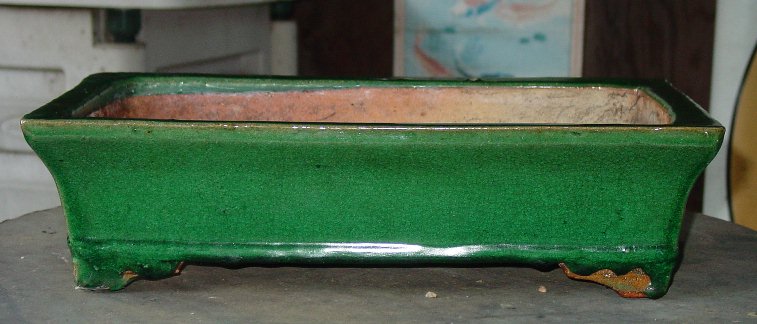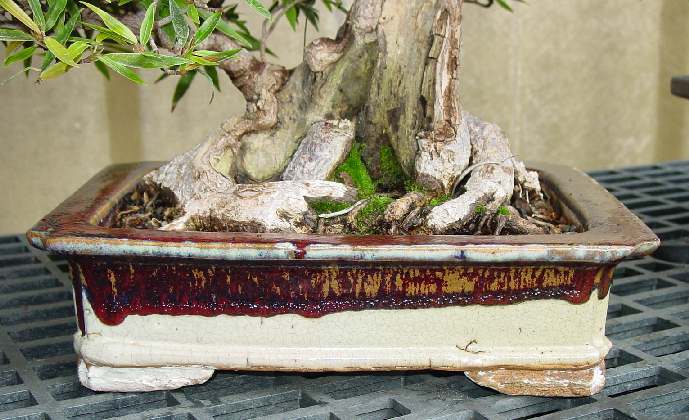How can you tell?
+8
JimLewis
Alan Walker
sulrich
Stone Monkey
Dale Cochoy
peter krebs
irene_b
fiona
12 posters
Page 1 of 2
Page 1 of 2 • 1, 2 
 How can you tell?
How can you tell?
Bit of a lame-brain question coming through here, I'm afraid, but put it down to curiosity and that Scottish thing about always wondering about money. I'm aware that potters have their signature "marks" but is there any sort of register that lists these, especially where it comes to antique pots?
Reason of course that I'm asking is, I bought a tree from someone four or five years ago, and they said at the time that the pot it was in was valuable because it was old. So how does a layperson like me find out if there is any truth in this or if it was a load of *********? I suspect the latter as the glaze to me doesn't show much sign of ageing. But what do I know really.
Here is a pic of the pot itself (dimensions are diameter circa 15 inches, height 6 inches):

This is the best I can get on the potter's mark. There is something pictorial and also the number 34 as a separate imprint.


Any insight greatly appreciated. And yes, sadly, the tree died!
Reason of course that I'm asking is, I bought a tree from someone four or five years ago, and they said at the time that the pot it was in was valuable because it was old. So how does a layperson like me find out if there is any truth in this or if it was a load of *********? I suspect the latter as the glaze to me doesn't show much sign of ageing. But what do I know really.
Here is a pic of the pot itself (dimensions are diameter circa 15 inches, height 6 inches):

This is the best I can get on the potter's mark. There is something pictorial and also the number 34 as a separate imprint.


Any insight greatly appreciated. And yes, sadly, the tree died!

fiona- Member
 Re: How can you tell?
Re: How can you tell?
There used to be online a potters mark website http://www.yamadori.nl/ but it is no longer working...
Irene
Irene
irene_b- Member
 Re: How can you tell?
Re: How can you tell?
Dear Fiona,
Unfortunately, your pot is not yet so old, so I guess 10 to max. 20 years.
This glaze is also still a hundred years ago still used.
The glaze is an edge-escape-glaze, it runs on uprisings, so the motive comes out better.
This is a beautiful pot, not sell!
Best regards
Peter
Unfortunately, your pot is not yet so old, so I guess 10 to max. 20 years.
This glaze is also still a hundred years ago still used.
The glaze is an edge-escape-glaze, it runs on uprisings, so the motive comes out better.
This is a beautiful pot, not sell!
Best regards
Peter

peter krebs- Member
 Re: How can you tell?
Re: How can you tell?
Thanks Peter. Any idea of the mark - is it a factory produced item or is this the mark of an individual potter? I was told it was Chinese but again that was said by the person who told me it was quite old so I'm a bit sceptical!

fiona- Member
 Re: How can you tell?
Re: How can you tell?
This is an interesting pot, especially the face and eye 'buttons' combining with the interesting 'rivet' button band.
As Peter mentioned, this was/is a common very old glaze still seen often today. There are also blue, red and gray glazes with identical properties. I have some pots of both glazes I could shoot if you are interested. Those particular pots were bought about 15ish years ago I guess by now from a NE USA Chinese importer. Very often these pots have chunks missing from the feet where the glaze dripped and stuck to shelves or other pots.
The spots shown on the bottom, although possibly iron deposits, I believe are coal splatters from a coal fired kiln much used in the past.
Regards,
Dale
As Peter mentioned, this was/is a common very old glaze still seen often today. There are also blue, red and gray glazes with identical properties. I have some pots of both glazes I could shoot if you are interested. Those particular pots were bought about 15ish years ago I guess by now from a NE USA Chinese importer. Very often these pots have chunks missing from the feet where the glaze dripped and stuck to shelves or other pots.
The spots shown on the bottom, although possibly iron deposits, I believe are coal splatters from a coal fired kiln much used in the past.
Regards,
Dale

Dale Cochoy- Member
 Re: How can you tell?
Re: How can you tell?
Fiona, this is a company stamp, in China it is not usual that a single pottery highlights
Peter
Peter

peter krebs- Member
 Re: How can you tell?
Re: How can you tell?
Thanks for the information guys. I rather like the pot and had been planning to use it for one of my larger pines. Having read Peter's post on the Bonsai board, I'm not now sure it looks aged enough, but once I've got the tree licked into shape I'll reconsider.
Dale, I'd be really interested in seeing those other glazes if you have anything to hand. Thanks for that kind offer.
A final question: what are the best web sites to look at for general info on pots antique, old and new?
best regards
Fiona
Dale, I'd be really interested in seeing those other glazes if you have anything to hand. Thanks for that kind offer.
A final question: what are the best web sites to look at for general info on pots antique, old and new?
best regards
Fiona

fiona- Member
 Re: How can you tell?
Re: How can you tell?
Fiona,
Here are pics of three pots that are possibly from the same kiln as yours. I wiped them off first with baby oil. The first two are about the same diameter as yours and show the old, but commonly used, green and blue glazes. Clay looks the same also.
The third I believe is also from the same kiln ( they all 3 came from same importer) but shows two other old but common glazes.
I also have two other pots, (not photo'ed) in same clay, from same kiln that are a lighter blue with whitish streaks,it is a fairly nice glaze and has a ficus nerifolia in it, and another with a horendous purple/blueish runny glaze. I use it as a training pot!
Dale



Here are pics of three pots that are possibly from the same kiln as yours. I wiped them off first with baby oil. The first two are about the same diameter as yours and show the old, but commonly used, green and blue glazes. Clay looks the same also.
The third I believe is also from the same kiln ( they all 3 came from same importer) but shows two other old but common glazes.
I also have two other pots, (not photo'ed) in same clay, from same kiln that are a lighter blue with whitish streaks,it is a fairly nice glaze and has a ficus nerifolia in it, and another with a horendous purple/blueish runny glaze. I use it as a training pot!
Dale




Dale Cochoy- Member
 Re: How can you tell?
Re: How can you tell?
Dear Fiona,
hello Dale
Here are some "green".
http://www.bonsaipots.net/index.php?page=how-lovely-green
I wish you a lot of fun to read.
Best regards
Peter
hello Dale
Here are some "green".
http://www.bonsaipots.net/index.php?page=how-lovely-green
I wish you a lot of fun to read.
Best regards
Peter

peter krebs- Member
 Re: How can you tell?
Re: How can you tell?
Dale. Many thanks again for those. It's very interesting to see comparable pots and although I don't claim to see instantly the similarities, I'm picking up more and more information, knowledge and insight every step along the way.
On another board I had posed the question about whether to be a "true bosai", a tree needed to be in a recognised container - be it pot or slab. Information such as yours and Peter's confirms in my own mind the essential nature of the pot to make up the overal integrated image. What I'm now beginning to realises is the big world of pot aesthetics that gets us to the right choice of pot as opposed to the "this one will do" hit or miss approach that many of us have adopted at some time or another. Sometimes the reason behind this are genuine (financial considerations leap out for a start) but I'm sure we probably went through a stage as beginners of not really appreciating fully what was needed. And I'm also now seeing clearly why some people collect and display pots for their own beauty. Thanks again for opening my eyes that wee bit further.

On another board I had posed the question about whether to be a "true bosai", a tree needed to be in a recognised container - be it pot or slab. Information such as yours and Peter's confirms in my own mind the essential nature of the pot to make up the overal integrated image. What I'm now beginning to realises is the big world of pot aesthetics that gets us to the right choice of pot as opposed to the "this one will do" hit or miss approach that many of us have adopted at some time or another. Sometimes the reason behind this are genuine (financial considerations leap out for a start) but I'm sure we probably went through a stage as beginners of not really appreciating fully what was needed. And I'm also now seeing clearly why some people collect and display pots for their own beauty. Thanks again for opening my eyes that wee bit further.
I think we've all got one of those lurking somewhere!Dale Cochoy wrote: another with a horendous purple/blueish runny glaze. I use it as a training pot!

fiona- Member
 Re: How can you tell?
Re: How can you tell?
Oh man! I'll not get any work done today as I will have to digest this in more detail.peter krebs wrote: Here are some "green". http://www.bonsaipots.net/index.php?page=how-lovely-green
I wish you a lot of fun to read.
From the quick glance I've had can I make the following observation which again may be well wide of target. The trees and pots in pics 14,15,16 and 17 from the link you provided above are to me more in what I think of as the Chinese penjing style. My introduction to bonsai was through a penjing colelction sent by Shanghai Botanic Gardens to the Glasgow Garden Festival in the mid-1980s and my consequent invovlement in maintaining that collection when it was gifted to the City of Glasgow. Many of the trees were in much deeper pots than I would associate with Japanese bonsai, and my reading on the topic (restricted admittedly) led me to believe that deeper pots was a feature of penjing (along with a freer form of styling). Is this reasonably true - that Chinese pots tend to be chunkier and Japanese ones more slimline or is that an over-simplification?
I'm getting hooked here.

fiona- Member
 Re: How can you tell?
Re: How can you tell?
Hi Fiona,
you can not certainly say so.
There are in China, Japan, USA, Europe and throughout the world, deep and shallow pots. The tree determines the pot, such as azaleas need a deeper pot, which is in the east or west the same.
regards Peter
you can not certainly say so.
There are in China, Japan, USA, Europe and throughout the world, deep and shallow pots. The tree determines the pot, such as azaleas need a deeper pot, which is in the east or west the same.
regards Peter

peter krebs- Member
 Re: How can you tell?
Re: How can you tell?
Hi Fiona
There used to be a big database on the net of potters and their stamps, signatures and chops but I can't find it anymore. The only other source I know of is http://www.artofbonsai.org/forum/viewtopic.php?f=29&t=2488
Regards
Andy
There used to be a big database on the net of potters and their stamps, signatures and chops but I can't find it anymore. The only other source I know of is http://www.artofbonsai.org/forum/viewtopic.php?f=29&t=2488
Regards
Andy

Stone Monkey- Member
 Re: How can you tell?
Re: How can you tell?
Good article Peter.
Some familiar shapes and glazes there.
In fact, picture #4 looks like the same mold and glaze as the one I showed, although I'm sure mine is a newer model. I wonder just how many times over the years some of those old molds have been reproduced?
Dale
Some familiar shapes and glazes there.
In fact, picture #4 looks like the same mold and glaze as the one I showed, although I'm sure mine is a newer model. I wonder just how many times over the years some of those old molds have been reproduced?
Dale

Dale Cochoy- Member
 Re: How can you tell?
Re: How can you tell?
Hi,
Best regards,
Stefan
This site has moved here: http://bonsaipotplaza.com/irene_b wrote:There used to be online a potters mark website http://www.yamadori.nl/ but it is no longer working...
Best regards,
Stefan

sulrich- Member
 Re: How can you tell?
Re: How can you tell?
Another question about this quite fascinating subject - a subject significantly more in depth than most non-potters would imagine I suspect. At the time I acquired my previously posted pot, I also got this one. It has no potter's mark of any sort that I can see. Is it too easy/incorrect to assume that if there is no mark then it came from some sort of mass-production facility somewhere. It has a kind of "home made" feel about it. Sorry for being a bore about pots now - I suppose part of me wants to find that rare and valuable antique, if only to finance a trip to Jose Luis and Co's event in Taiwan at the end of October. I'm not holding my breath too much over this particular pot, but one never knows! Any comments welcome, even if it's just to tell me to use it as crocks for my patio planters.
Length = 50cm/20inches, breadth = 37cm/15inches, height = 10cm/4inches

Length = 50cm/20inches, breadth = 37cm/15inches, height = 10cm/4inches

Last edited by fionnghal on Tue Jul 28, 2009 3:11 pm; edited 1 time in total (Reason for editing : ambiguosity)

fiona- Member
 Re: How can you tell?
Re: How can you tell?
The bas-relief decoration and glaze treatment on your pot looks Chinese in origin to me. It may have hand done work on it. Does the bottom of the pot show evidence of the clay being rolled on canvas?

Alan Walker- Member
 Re: How can you tell?
Re: How can you tell?
How would that manifest itself, Alan? Before I start seeing things that arent there!

fiona- Member
 Re: How can you tell?
Re: How can you tell?
sulrich wrote:Hi,This site has moved here: http://bonsaipotplaza.com/irene_b wrote:There used to be online a potters mark website http://www.yamadori.nl/ but it is no longer working...
Best regards,
Stefan
Thanks for this one. I'd lost it. That crab sig on the "Unknown" page is my little mame pot. I've been trying to ID it for years.

JimLewis- Member
 Re: How can you tell?
Re: How can you tell?
sulrich wrote:Hi,This site has moved here: http://bonsaipotplaza.com/irene_b wrote:There used to be online a potters mark website http://www.yamadori.nl/ but it is no longer working...
Best regards,
Stefan
Thank You very much Stefan!!
Irene
irene_b- Member
 Re: How can you tell?
Re: How can you tell?
Dear Fiona,
I am very sorry and I hope you're not too disappointed.
Unfortunately, this is a newer pot.
The motive of the pot is an ancient motif.
See here:
http://www.bonsaipots.net/index.php?page=blue-decorated-pots-3
At the end of the article is a photo of a pot, as you have it.
Unfortunately, this is a mass product, and the glaze is a glaze without risk, see the text of the article.
Best regards
Peter
I am very sorry and I hope you're not too disappointed.
Unfortunately, this is a newer pot.
The motive of the pot is an ancient motif.
See here:
http://www.bonsaipots.net/index.php?page=blue-decorated-pots-3
At the end of the article is a photo of a pot, as you have it.
Unfortunately, this is a mass product, and the glaze is a glaze without risk, see the text of the article.
Best regards
Peter

peter krebs- Member
 Re: How can you tell?
Re: How can you tell?
Hi Dale,
these pots are a hundred thousand times been pottery.
There are regions, for example, there are living 10-20 potter families. All the families get their clay from the same place. The glazes are all very similar.
One way to produce a mould similar to ancient Chinese pottery is a cinch. Stamp under the pot make only a few years ago, when they had noticed, they can better sell.
Twenty years ago there were lots of good old green bowls in Germany, but then nobody wanted to buy.
Today you pay 500 to 600 euros for an old green bowl, (see my article "green pots" in Image No. 3/4/6 / and 13).
When they don't have patina and there are countless, they have no great value.
Nice are these pots anyway, and it can be very good plant.
Best regards
Peter
these pots are a hundred thousand times been pottery.
There are regions, for example, there are living 10-20 potter families. All the families get their clay from the same place. The glazes are all very similar.
One way to produce a mould similar to ancient Chinese pottery is a cinch. Stamp under the pot make only a few years ago, when they had noticed, they can better sell.
Twenty years ago there were lots of good old green bowls in Germany, but then nobody wanted to buy.
Today you pay 500 to 600 euros for an old green bowl, (see my article "green pots" in Image No. 3/4/6 / and 13).
When they don't have patina and there are countless, they have no great value.
Nice are these pots anyway, and it can be very good plant.
Best regards
Peter

peter krebs- Member
 Re: How can you tell?
Re: How can you tell?
Well, you know what canvas looks like, don't you? When a slab of clay is rolled out flat on a canvas cloth, it will make an imprint on the surface of the clay slab which looks like the canvas. A pot which is made from slip poured into a mold will not have such markings. This is just one indicator and is not definitive.fionnghal wrote:How would that manifest itself, Alan? Before I start seeing things that arent there!

Alan Walker- Member
 Re: How can you tell?
Re: How can you tell?
That's kind of what I thought, and there are markings which could be something of that sort on the base. I'd be really interested if you can tell me more about the process.
Many thanks
Fiona
Many thanks
Fiona

fiona- Member
 Re: How can you tell?
Re: How can you tell?
Better ask one of the active potters. It's been almost 40 years since I did my last potting in college. Back then we would make slabs of clay by first wedging it to get out any air bubbles, the rolling it flat with a rolling pin (like making pie crust) on a flat surface covered with canvas. The canvas is a convenient surface which usually doesn't stick to the clay.fionnghal wrote:That's kind of what I thought, and there are markings which could be something of that sort on the base. I'd be really interested if you can tell me more about the process.
Many thanks
Fiona
The pros use extruders and other convenient equipment not available to the hoi polloi.

Alan Walker- Member
Page 1 of 2 • 1, 2 
Page 1 of 2
Permissions in this forum:
You cannot reply to topics in this forum






